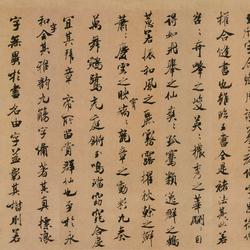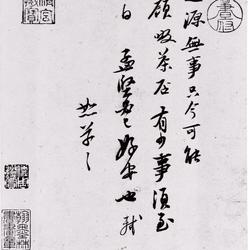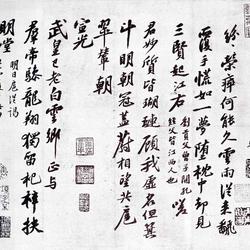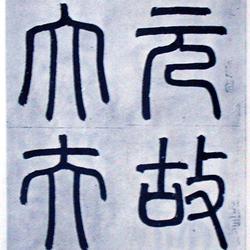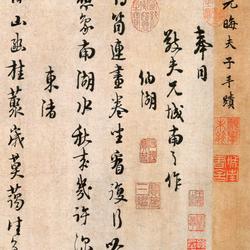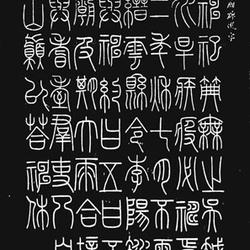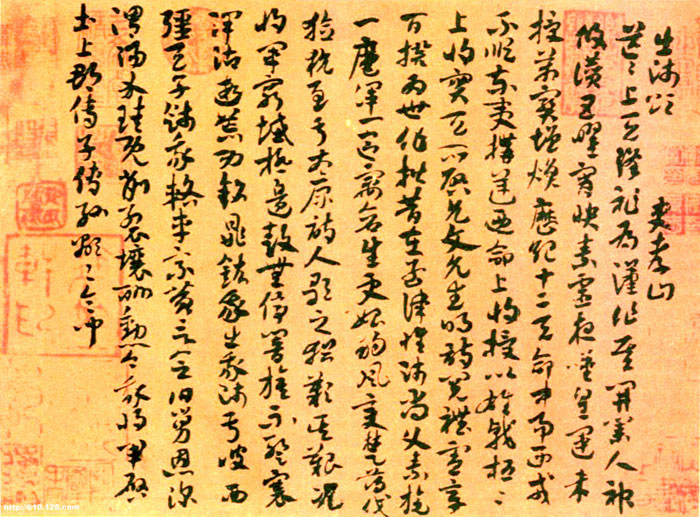
Volume "Ode to Become a Master" written by Sui people (passed as Suo Jing Shu of the Western Jin Dynasty), paper, Zhang cursive script, 21.2cm in length and 127.8cm in width.
Explanation of "Ode to the Master".
The vast sky descends Zuo to the Han Dynasty to establish the foundation and open the business. People and gods praise each other. The five rays shine at night.
Su Ling sighs at night, the emperor’s luck has not been granted, the treasures are brightening, the twelve years of history are destined to change.
The Western Rong were disobedient and the Eastern barbarians rebelled. The general was ordered to confer a male halberd to General Huan Huan.
Inspired by the heaven, allowed by the text and the military, read the poems and rituals of the Ming Dynasty, chartered by Bai Kui, and set a standard for the world.
In the past, when I was in Mengjin, I was the only master who respected my father. Su Yan lived under his command in Hun District, and the people began to change.
The wind changes the state of Chu, and the lynxes are hunted down. As for Taiyuan, the poet still sighs at the difficulty when he sings about it.
General Kuang, at the extreme end of the restricted area, the drums never stop ringing, the flag never wavers (the upper left part of the character is "car"), Hunyu is in the wilderness, the merits are inscribed with Dinghong (remove the cover and add gold on the right)
I left my division and went to the western frontier. The emperor gave me a farewell. I rode in a chariot in the Yellow River. I remembered my old work.
My kindness to Weiyang has been cut, and the soil has been split to reward the honor. Now I am the general, and I am going to the county.
Pass down from descendant to grandson, reveal the order and hear the news
"Ode to the Master" has been circulating in an orderly manner since the Tang Dynasty. In the Tang Dynasty, it was collected by Princess Taiping. In the Song Dynasty, it was collected by the palace during the Shaoxing period. In the Ming Dynasty, it was collected by the famous collector Wang Shimao. Emperor Qianlong once included it in the "Sanxitang Dharma Tie". In 1922, the abdicated Qing Emperor Pu Yi took the volume out of the palace in the name of rewarding Pu Jie, and it was lost among the people after 1945. In July 2003, it suddenly appeared at China Guardian's 2003 spring auction, causing an uproar in the industry.
This piece has no title. There are 22 collection seals, including: the Sanskrit seal of Princess Taiping of the Tang Dynasty "San Miao Mu Tuo", the seal of "Yue" and "Shao Yue's Seal" by Li Yue of Tang Shao King, and the "Eternal Preservation Secret" of Tang Zhongshu Shilang Wang Ya (two seals) Department); Song Gaozong's "Shao" and "Xing" (Lianzhu Seal), Song Neifu's "Shu Seal" (half seal) and "Inner House Secretary's Seal"; the "Li Lixuan Seal" and "Eternal Dynasties Yong Seal" of the people before the Ming Dynasty "Bao", "Liu Clan's Zhongshou", "Liu Wan's Private Seal", "Anyuan Zhong Seal" and two seals with indistinguishable text; Qing Anqi's "Yi Zhou Collection", Qing's Inner Palace "Qianlong's Imperial Treasure", The seals include "Shiqu Baoji", "Leshou Hall Appreciation Treasure", "Qianlong Appreciation", "Sanxi Hall Jingjian Seal" and "Yi Zisun".
The postscript of Mi Youren of the Song Dynasty on the later paper reads: "Ode to the Master on the right, written by Xian of the Sui Dynasty, approved by Mi Youren on April 7, 9th year of Shaoxing." On the lower right is the seal of the Doctor of Supervision of Calligraphy and Painting. There are 6 seals on the left, including: "Wu" (half seal), "□Xuan", "□□ Shanmu", "Guxi Emperor", "Shou" and one seal with indiscernible text. There are 6 collection seals on the right, which are "Treasure of the Zhou Family of Anyi", "Treasure of the Five Blessings and Five Dynasties", "Treasure of the Bazheng Cang Nian", "Treasure of the Imperial View of Jiaqing", "Appreciation of Xuantong", and "Essence of Wuyi Zhai". "Jianxi".
It is preceded by the two characters "Jin Mo" in seal script and the monogram "五", and is stamped with the seal "Yu Fu Shu". According to the stamp and seal, the predecessors determined it to be the book of Emperor Gaozong of the Song Dynasty, but it was actually imitated by the Ming Dynasty. There are also seals from the Imperial Household of the Qing Dynasty: "Tai Shang Emperor", "Shiqu Ding Jian", "Bao Ji Re-edited", and "Ningshou Palace continues to include Shi Qu Bao Ji". On the upper left is a paragraph inscribed by Emperor Qianlong Guisi (38th year, 1773).
The seals on the front of the collection across the water include: Ming Dynasty Wang Shimao's "Book Collection of Langya King Jingmei", Qing Anqi's "An" and "Yi Zhou Jiantang", Qing Neifu's "Ba Zheng Cang Nian Treasure". Later, across the water, there was an imperial inscription of Emperor Qianlong's reign (13th year, 1748), with the seals of "Qian" and "Long", and the Qing'an Qijianzang seal "Lucun".
This book is recorded in: Ming Dynasty Zhan Jingfeng's "Dongtu Xuanlan", Wang Shizhen's "Yanzhou Mountain Man's Continuation", Wu Qizhen's "Wu Family Calligraphy and Painting Notes", Sun Kuang's "Calligraphy and Painting Postscript", Qing Dynasty Gu Fu's "Life" "Spectacular", An Qi's "Mo Yuan Hui Guan", Wu Sheng's "Daguan Lu", "Shiqu Baoji Continuation: Ningshou Palace", Ruan Yuan's "Shiqu Essays", Sun Yuebian's "Peiwenzhai Calligraphy and Painting Manual", Ni Tao's " "Six Arts One Record" and other books. Engraved into "Sanxitang Dharma Notes".
According to the bibliography and collection seals, this book is called the "Shaoxing version" of "Ode to the Master". According to Mi Youren's postscript, it is mostly attributed to the Sui Dynasty. It is also believed to be written by Suo Jing of the Western Jin Dynasty or Liang Xiao Ziyun of the Southern Dynasty, or even by the Tang Dynasty. The general circulation situation is as follows: in the Tang Dynasty, it was collected by Princess Taiping, Li Yue and Wang Ya successively; in the Shaoxing period of the Southern Song Dynasty, it entered the inner palace; in the Ming Dynasty, it returned to Wang Shimao; in the early Qing Dynasty, it was collected by An Qi and later entered the inner palace of Qianlong; in the eleventh year of the Republic of China (1922) On the ninth day of the lunar month, Pu Yi took it out of the palace in the name of rewarding Pu Jie. After 1945, it was scattered and hidden among the people for more than 60 years. In 2003, it was acquired by an auction company and the Palace Museum bought it back with a huge sum of money.
"Ode to the Master" as a well-circulated chapter and ink ink has been preserved in two copies, one is the "Shaoxing version" and the other is the "Xuanhe version". The latter was once included in the Northern Song Dynasty. It has the title of "Conquering the West Sima Suo" by Emperor Huizong of the Song Dynasty. Jingshu" and "Xuanhe" ladle seals are generally identified as Suojingshu of the Western Jin Dynasty, and some are also believed to be Liang Xiaoziyun's. It is recorded in "Shigutang Calligraphy and Painting Collection" and other books. The general situation of its circulation is as follows: it entered the Xuanhe inner palace in the Northern Song Dynasty, and seemed to be transferred from Yansong's family to Wenpeng's hands in the Ming Dynasty. It was later sold to Xiang Yuanbian and disappeared after entering the Qing Dynasty. The "Xuanhe Edition" was engraved in Dong Qichang's "Xihongtang Tie", and Wang Kentang's "Pomo Zhai Tie" was also copied. Today, only the rubbings of Fa Tie remain.
The Shaoxing version of "Ode to the Master" has an unnamed inscription. Later generations believe that it was written by Suo Jing of the Western Jin Dynasty or Liang Xiao Ziyun of the Southern Dynasty, or that it was written by Sui Xian or Tang Dynasty. There is no conclusion. Judging from the collection seals of Princess Taiping, Li Yue, Wang Ya and others of the Tang Dynasty in this painting, it can be seen that the writing was not later than the early Tang Dynasty. According to Mi Youren's postscript of Song Dynasty, it is regarded as "Sui Xian Shu" which is more credible. This book is a typical early cursive calligraphy style. The "silkworm head and phoenix tail" has traces of official script, and the "silver hook and tail" has the characteristics of cursive script. The overall calligraphy style is regular but changes, and the natural flying style can be seen in the strength. The style, simple and elegant, is the traditional style that has been used to standardize Zhangcao since the Six Dynasties. It only has a slightly more elegant style, which is roughly similar to the cursive style in Sui Zhiyong's "Zhencao Thousand Character Essay". Therefore, it is appropriate to designate it as a Sui Dynasty book.

